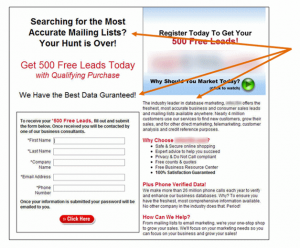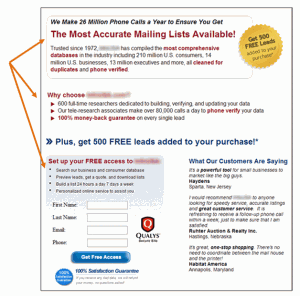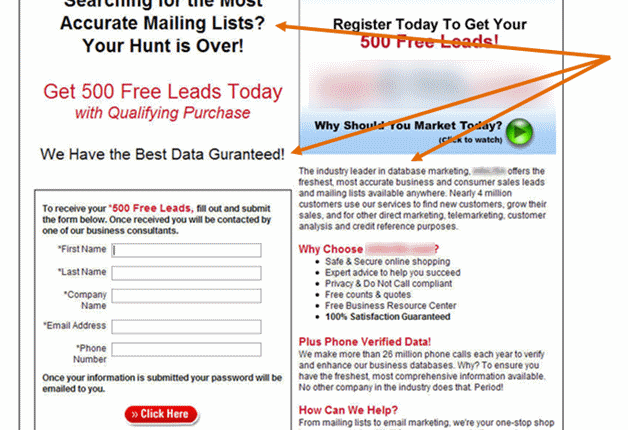The most sensational, inspirational, celebrational …
No, I’m not talking about “The Muppet Show.” I’m talking about the overhyped marketing message.
Whether it’s because the breathless wording of the message is simply ridiculous (e.g., Less wrinkles in only minutes!) …
… or because the information is of specious lineage (e.g., Chevy’s promotion of its Consumers Digest awards) …
… or because the company and message don’t match (e.g., The Onion wryly spoofs the practice of companies advertising government-ordered environmental cleanups) …
… marketers can shoot themselves in the foot hyping incredible claims when the customer is simply looking for a credible option.
Adam Lapp, Associate Director of Optimization, MECLABS, summed up the challenge most marketers face nicely in the title to this blog post. After optimizing hundreds, if not thousands of landing pages, emails, PPC ads, etc. over the past few years (and consistently delivering double and triple-digit lifts to boot), Adam has a simple message for the marketers of the world — be credible…
“People don’t buy from you because you say that you are the leading this or the largest that, or because you have a clever slogan. No, they buy from you because you have a good product. All you have to do is communicate to them in honest, no-nonsense terms why it’s good.”
How believable are your claims?
Even if your product is amazing, you will need reliable sources and proof that it works.
As marketing professional and author Al Ries has said …
“Advertising has no credibility with consumers, who are increasingly skeptical of its claims and whenever possible are inclined to reject its message.”
Once people try the product and it works, then you are on your way to sustainable results.
So how do you improve the credibility of your marketing and advertising communications?
Notice I said “and it works.” First and foremost — don’t be shady. Make sure there is true value in your marketing proposition.
OK, now that we’ve chased off all of the scammers, here are five tips for increasing credibility, most of which were taken from Transparent Marketing by Flint McGlaughlin, Managing Director, MECLABS …
Let someone else do your bragging
Third-party indicators, such as a Better Business Bureau seal, help reduce anxiety. So do testimonials and social proof via review sites, social media and honest, balanced (i.e., not cherry picked) comments and reviews on your own site.
For example, PETCO.com tested various positions for the Hacker Safe seal it has on its homepage. Just by changing the location of the seal within the design of the page, the team was able to increase conversion of visitors to sales by more than 8%.
Tell (only) the (verifiable) truth
As Flint said in Transparent Marketing, “If the Postmodern Consumer can’t instantly verify a claim, he will assume that it is false.”
Substitute general descriptions with specific facts (qualitative vs. quantitative)
Specificity. Be very specific with quantitative facts. If you need to use qualitative facts, see if a third party has said it for you.
Some examples that Aimee Thompson, Office Administrator, MECLABS, was kind enough to dig up from our Research Directory …
NOT THIS: “Fully managed dedicated services by the hosting experts … backed by proven accreditations.”
BUT THIS: “… the highest level of global accreditation. We are the only data center to hold the ISO27001, AS/BS7799, SunTone, RedHat, ASIO and DSD certifications.”
NOT THIS: “… we provide reliable services …”
BUT THIS: “All our solutions are backed by stringent Service Level Guarantees with cash rebates for under-performance: 1) 99.9% uptime guaranteed 2) guaranteed response time 3) guaranteed time to repair.”
NOT THIS:
Statements like, “Most Accurate Mailing Lists … We have the best data … Industry leader in database marketing,” are all prominent, vague qualitative statements throughout the original copy below.

BUT THIS:
Previous vague statements have been replaced with quantitative statements like, “We make 26 Million Phone Calls … Trusted since 1972 … 210 million U.S. consumers … 600 full-time researchers.”

The first headline did nothing to engage the reader with credibility or drive the reader to the content. The tone of the headline had a sales approach.
You need to engage the consumer. The point of the headline is not to sell a product but rather to get the customer to read the first paragraph.
The new page has credibility. But, interestingly enough, the old page had credible statements as well; they were just buried in small font at the bottom right of the page.
“Most of the Research Partners I’ve had a chance to work with have a value proposition; they just don’t express it clearly,” Adam said. “And this whole thing about not being a copywriter is a lame excuse. More often than not, when I ask somebody to explain to me why I should buy their product, they have no problem verbally doing so. That’s your copy. Bottle it up and sell it on your page.”
RESULTS
The results of this change? In an A/B split test, the new, more credible page generated 201% more leads. (It should be noted that credibility likely wasn’t the only factor. The new landing page also had more force and appeal.)
Admit your weaknesses
You can’t possibly be everything to everyone. So tell your customers what you can’t do.
This isn’t new advice. For example, Doyle Dane Bernbach’s famed print ad for Volkswagen from 1966 had the headline, “Ugly is only skin-deep.” The first line of copy said, “It may not be much to look at.” By admitting the VW’s notable lack of style for the era, the ad could then focus on the car’s positive qualities in a more believable way.
In a more recent example, River Pools and Spas garnered 176 comments, 396 inbound links, 55,432 page views, and ranked #1 in Google for 10 (lead-generating) keywords simply by writing transparent blog posts.
We’ve talked about print ads and content marketing — executions where you have plenty of room to get into the nuances of why your product or service might have a weakness — but what about in the few characters you have in a subject line? Here is a recent test we ran …
Subject Line Treatment #1: Win $1,900 worth of marketing training
Subject Line Treatment #2: This subject line could be better
Body of email:
Fellow evidence-based marketer,
The subject line for this email could be much better. The subject line for every email could do a more effective job of getting your audience to open, click and convert.
That is why we test. And optimize.
For our next subject line test, we wanted to challenge the model and think outside the box a little, so we’re turning to you — an audience of professional marketers — to tell us which subject line will be most effective for our next experiment.
The winning subject line in our test will receive a free ticket to Optimization Summit 2012, plus a free MarketingExperiments Landing Page Optimization Online Course. That’s a $1,900 value.
For more details, and to send in your subject line, click here.
Thanks for your help. And keep testing,
Daniel Burstein
Director of Editorial Content
MECLABSP.S. Our job is to help you do your job better. Let us know how we can help.
Results:
The “admit your weaknesses” subject line generated 11.5% more unique opens than the powerful incentive subject line (significant at a 95% level of confidence) and generated a 21% higher unique clickthrough rate (significant at a 95% level of confidence).

On the face of it, that’s somewhat surprising. After all, $1,900 worth of free marketing training is surely more appealing than an admittedly weak subject line. However, the average email recipient has been so overpromised by subject lines (with emails that fail to live up to the promise) that the credible subject line probably piqued their curiosity, and was also simply more believable than the obvious hard sell of the incentive.
Be careful not to refute your efforts with opposing elements of your website, customer interactions or anything else
Tell one clear story. And tell it well.
To do that, you have to operate as a team. Make sure the designer, copywriter, developer, sales reps or anyone else involved in conveying your message is marching to the same drummer.
Related Resources:
Transparent Marketing: Do your campaigns sound like North Korean propaganda?
Competitive Messaging: Tell your customers what you can’t do




Agreed. There’s no countering the old “build a better mousetrap” idea. It’s very tempting in writing copy to offer the broader statements simply because that’s so prevalent in the marketplace today. “Our company care about synergy”, et al. Yet it’s far more helpful for your branding definition ro just let the facts speak for themselves. To paraphrase another article I was reading today, we want to create advocates, not hire ambassadors.
Excellent post.
I especially like the ‘admit your wekanesses’ point.
We try really hard to get clients to do just this. It’s totally unexpected and doubles credibility.
We did a post on 17 credibility builders that your readers may like, too.
It’s here:
http://www.velocitypartners.co.uk/2008/03/28/17-credibility-builders-that-make-your-claims-believable/
(Sorry if this feels spammy — feel free to delete if you think it is:)
Reading your comment about ‘value in your market proposition’ reminds me I read somewhere on your site during 2011 that Meclabs was writing a book on Value Propositions. Is this available for purchase yet?
Hi Andre,
It’s been a long time coming. Unfortunately, it’s still not done. Rest assured, however, that we haven’t forgotten it. We’re still working hard on it.
Daniel – i like your “let someone else do the bragging”. that’s where you use some of your customer proof points (testimonials, reviews, social proof, photos, whatever customer content).
you said it well when you say “only the verifiable truth”. i did a post few weeks back where i was talking about fake testimonials and the google test. you might find it useful – http://customertestimonials.wordpress.com/2014/02/01/best-practices-series-how-to-keep-testimonials-real-and-reasons-why-not-to-fake-them